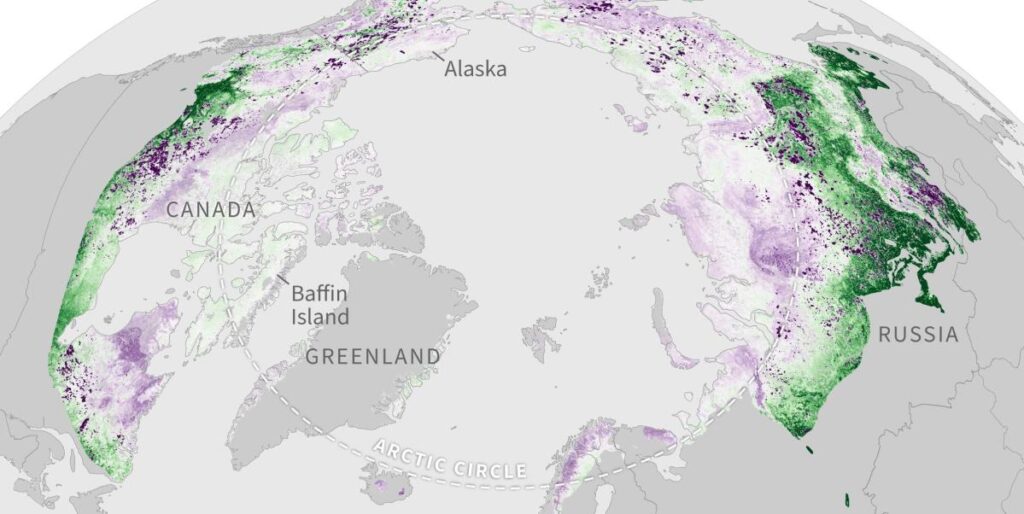The Arctic has been a focal point of concerning environmental shifts in recent years, with experts highlighting a drastic transformation in how this fragile ecosystem operates under the duress of climate change. Historically, the Arctic served as a crucial carbon sink—absorbing more carbon dioxide (CO2) than it emitted, largely due to the photosynthetic processes of its flora and the carbon storage capabilities of its permafrost. However, recent findings from the National Oceanic and Atmospheric Administration’s (NOAA) 2024 Arctic Report Card indicate a significant pivot; the Arctic is transitioning from a carbon-storing biome to a source of emissions. This shift in carbon dynamics carries profound implications not only for the Arctic itself but also for global ecosystems and climate stability, marking a concerning milestone in the ongoing climate crisis.
The consequences of warmer temperatures and intensified wildfires in the Arctic tundra—an ecosystem typically characterized by extreme cold and a thin layer of permafrost—have become increasingly alarming. As global temperatures climb, permafrost is thawing more extensively than ever before. The 2024 report revealed that permafrost temperatures in Alaska were among the highest recorded, leading to the degradation of its carbon-retaining capacity. As these carbon repositories decompose, carbon that was once safely stored is being released into the atmosphere. This change has the potential to exacerbate the greenhouse gas effects already felt worldwide, as the Arctic begins to contribute to the very emissions it historically helped to mitigate.
Moreover, the newfound carbon emissions from the tundra are compounded by the increased frequency and intensity of wildfires. In 2024, the Arctic experienced the second highest levels of wildfire emissions ever recorded, leading to substantial increases in carbon output. As wildfires rage across the polar landscape, they not only release stored carbon but also create a vicious cycle that further weakens the tundra’s ability to act as a carbon sink. The interlinking effects of wildfires and thawing permafrost mean that the Arctic is now contributing to the rising levels of greenhouse gases, posing an urgent challenge to climate scientists.
Rich Spinrad, NOAA’s administrator, emphasizes the concerning trend of the Arctic emitting more carbon than it sequesters, illustrating a crucial tipping point in our understanding of this unique biome. This outcome is particularly worrying as it points to the inadequacy of current global efforts to reduce fossil fuel emissions. The Arctic’s new role as a net emitter of carbon underlines the urgency of addressing fossil fuel pollution and the grave consequences that stem from inadequate climate action. As the Arctic becomes increasingly vulnerable to climate-induced changes, its past role as a stabilizer within the global carbon cycle is severely compromised.
The implications of these findings extend beyond the Arctic region, foretelling dire consequences for habitats and human populations further south. Escalating greenhouse gas emissions can lead to more extreme weather patterns, rising sea levels, and a host of related impacts that affect biodiversity and ecosystems worldwide. As emissions from the Arctic rise, there are fears about not just the regional effects but also the broader environmental repercussions. This alarming news reaffirms the interconnected nature of climate systems and how changes in one region can trigger significant responses across the globe.
In conclusion, the profound changes underway in the Arctic highlight the critical need for more robust climate action and the urgent requirement to mitigate fossil fuel emissions. The transformations observed in the Arctic tundra illustrate a turning point in the behavior of carbon sinks and signify the complexities of global climate interactions. As the world grapples with the reality of a warming planet, paying close attention to the developments in the Arctic becomes essential for mitigating climate impacts and protecting our shared environment for future generations. The NOAA Arctic Report Card serves as a stern reminder of the stakes involved and the necessity for concerted global efforts to combat climate change at its roots.

